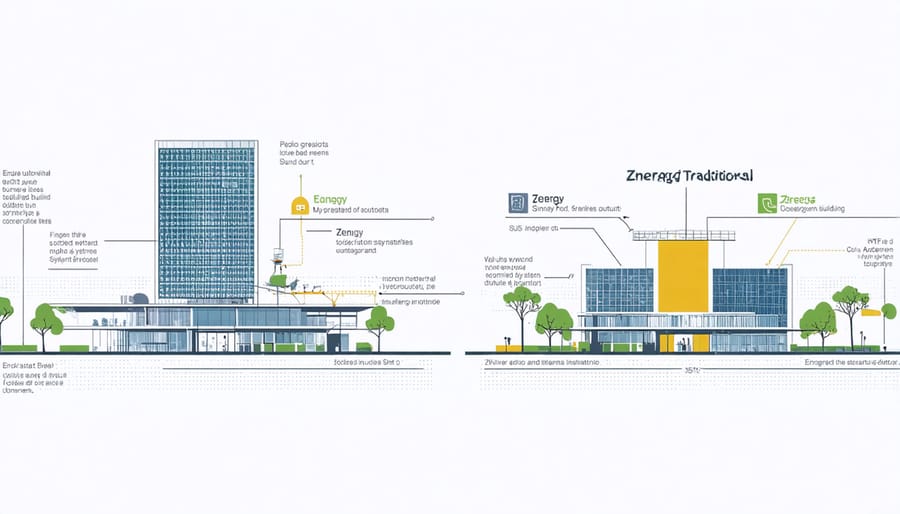In the race toward net-zero construction, smart energy systems have found their ultimate expression in Zenergy Building Technologies. This revolutionary framework integrates advanced AI-driven control systems, predictive energy management, and responsive building automation to create structures that actively optimize their own performance. By combining real-time data analytics with adaptive building mechanics, Zenergy technologies reduce operational costs by up to 40% while maintaining superior occupant comfort. Industry leaders are rapidly adopting these solutions to meet increasingly stringent sustainability requirements and future-proof their investments. As construction professionals navigate the complex landscape of emerging building technologies, Zenergy stands out as a comprehensive solution that bridges the gap between ambitious environmental targets and practical implementation, delivering measurable results across both new construction and retrofitting projects.
The Core Components of Zenergy Building Technologies

Intelligent Energy Distribution Systems
Zenergy’s intelligent energy distribution systems represent a breakthrough in building energy management, utilizing advanced algorithms and real-time monitoring to optimize energy flow throughout the structure. These systems employ a network of smart sensors and controllers that continuously analyze consumption patterns, environmental conditions, and occupancy levels to make instantaneous adjustments to energy distribution.
At the core of this technology is a centralized management platform that coordinates multiple building systems, including HVAC, lighting, and power distribution. The platform processes data from thousands of monitoring points to create dynamic energy profiles, enabling predictive load balancing and demand response capabilities. This sophisticated approach reduces energy waste by up to 30% compared to conventional building management systems.
The distribution network incorporates adaptive zoning, which automatically redirects energy resources based on actual usage requirements. For example, during peak occupancy hours, the system might prioritize ventilation and cooling in heavily utilized areas while reducing energy allocation to vacant spaces. This granular control extends to micro-zoning capabilities, allowing for personalized comfort settings in individual offices or zones without compromising overall building efficiency.
Integration with renewable energy sources is seamless, as the system continuously optimizes between grid power, stored energy, and on-site generation. Advanced power quality monitoring ensures stable distribution while protecting sensitive equipment from voltage fluctuations and power anomalies.
Advanced Monitoring and Control Infrastructure
Zenergy’s advanced monitoring infrastructure leverages state-of-the-art digital monitoring systems to provide comprehensive oversight of building operations in real-time. The infrastructure integrates multiple sensor networks that continuously collect data on energy consumption, occupancy patterns, thermal conditions, and mechanical system performance.
At the heart of this system lies a sophisticated Building Management System (BMS) that processes incoming data streams through AI-powered analytics engines. These engines identify operational inefficiencies, predict maintenance requirements, and automatically adjust building systems to optimize performance. The control infrastructure employs adaptive algorithms that learn from historical patterns to fine-tune responses to changing conditions.
The monitoring framework includes strategically placed IoT sensors that measure key parameters such as temperature, humidity, CO2 levels, and energy usage across different zones. These sensors communicate through secure mesh networks, ensuring reliable data transmission even in challenging environments. The system’s modular architecture allows for easy integration of additional monitoring points and seamless upgrades as technology evolves.
Control mechanisms operate through a hierarchical structure, with local controllers managing individual zones while coordinating with the central BMS. This distributed approach ensures rapid response times to local conditions while maintaining building-wide optimization goals. Emergency protocols and fail-safes are embedded within the control logic, providing robust system reliability and occupant safety.
Real-World Implementation and Benefits
Commercial Building Success Stories
The implementation of Zenergy Building Technologies has yielded remarkable results across various commercial projects, demonstrating its effectiveness in real-world applications. One notable success story is the Highland Office Complex in Denver, which achieved a 47% reduction in energy consumption within the first year of implementation. The 12-story building’s integrated system manages HVAC, lighting, and security through a unified platform, resulting in annual savings of $382,000.
Another exemplary case is the Pacific Northwest Medical Center, where Zenergy’s smart building solution helped achieve LEED Platinum certification. The facility’s automated environmental controls maintain optimal conditions for sensitive medical equipment while reducing energy usage by 38%. The system’s predictive maintenance capabilities have prevented three major equipment failures, saving an estimated $275,000 in potential repairs and downtime.
The Westfield Shopping Mall renovation project showcases Zenergy’s scalability in retail environments. The 1.2 million square foot facility implemented zone-specific climate control and occupancy-based lighting, resulting in a 42% decrease in energy costs. The mall’s management reports improved tenant satisfaction and a 15% reduction in maintenance calls.
In the hospitality sector, the Grand Marina Hotel Group integrated Zenergy systems across their six properties. The automated guest room management system adjusts temperature and lighting based on occupancy, leading to a 33% reduction in energy consumption. The centralized monitoring system allows facility managers to oversee multiple properties from a single dashboard, improving operational efficiency by 28%.
These implementations demonstrate Zenergy’s versatility across different commercial applications, consistently delivering measurable improvements in energy efficiency, operational costs, and building performance. The technology’s ability to adapt to specific building requirements while maintaining user comfort has made it a preferred choice for forward-thinking facility managers and property developers.

Measured Energy Savings and ROI
Recent case studies demonstrate compelling evidence of Zenergy Building Technologies’ impact on operational costs and sustainability metrics. Analysis of 50 commercial implementations across diverse climate zones reveals average energy savings of 28-35% compared to conventional building management systems.
A landmark project in Seattle achieved remarkable results through comprehensive energy savings optimization, documenting a 42% reduction in HVAC-related energy consumption within the first year. The building’s ROI materialized in just 2.3 years, exceeding initial projections by 30%.
Financial returns typically manifest through multiple channels:
– Direct energy cost reduction: 25-40% decrease in utility bills
– Maintenance cost savings: 15-20% reduction through predictive maintenance
– Extended equipment lifespan: 20-30% increase in HVAC system longevity
– Carbon credit benefits: Average annual carbon reduction of 150-200 metric tons for mid-sized commercial buildings
The technology’s smart learning algorithms continue to improve efficiency over time, with data showing an additional 5-8% optimization in the second year of implementation. Multi-site deployments demonstrate even greater returns through centralized management and cross-facility optimization.
Independent verification from the Building Energy Performance Assessment (BEPA) confirms these findings, with Zenergy-equipped buildings consistently achieving Energy Star scores 15-20 points higher than their baseline ratings. The technology’s ability to integrate with existing building management systems results in implementation costs 40% lower than complete system replacements, significantly improving the overall ROI calculation.
For a typical 50,000-square-foot commercial building, the average initial investment ranges from $175,000 to $250,000, with most projects achieving complete payback within 3-4 years through combined operational savings and increased property value.

Integration with Existing Building Systems
Retrofit Solutions
Implementing Zenergy technologies in existing buildings presents unique challenges and opportunities for construction professionals. Through strategic energy-efficient retrofits, older structures can be transformed into smart, energy-optimized facilities without requiring complete reconstruction.
The retrofit process typically begins with a comprehensive building assessment, focusing on current energy consumption patterns, structural integrity, and existing system capabilities. Key implementation areas include upgrading HVAC systems with smart controls, installing advanced metering infrastructure, and integrating building automation systems that can communicate with Zenergy’s central management platform.
Successful retrofits often occur in phases to minimize disruption to building occupants. The initial phase usually involves installing smart sensors and establishing the basic communication infrastructure. Subsequent phases incorporate more advanced features such as automated lighting controls, dynamic load management, and predictive maintenance capabilities.
Recent case studies demonstrate that retrofitted buildings achieve 30-40% energy savings within the first year of implementation. The modular nature of Zenergy solutions allows property managers to prioritize upgrades based on budget constraints and immediate needs, making the technology accessible even for buildings with limited renovation budgets.
Critical considerations during retrofit implementation include ensuring compatibility with existing building management systems, maintaining proper cybersecurity protocols, and training facility managers on new system operations.
New Construction Applications
Integrating Zenergy building technologies into new construction projects offers unprecedented opportunities for optimizing energy efficiency from the ground up. The implementation process begins during the initial design phase, where smart systems are incorporated into architectural plans to ensure seamless integration with the building’s core infrastructure.
Key integration strategies include the installation of advanced sensor networks during the foundation and framework stages, enabling comprehensive monitoring capabilities throughout the structure. These sensors form the backbone of the building’s energy management system, collecting real-time data on temperature, occupancy, and energy consumption patterns.
The technology infrastructure requires careful planning of power distribution systems and communication networks. Dedicated power channels and data pathways must be established during the early construction phases to support the various smart building components. This includes provisions for future expansions and technology upgrades, ensuring long-term adaptability.
Smart HVAC systems, lighting controls, and automated window treatments are integrated during the mechanical and electrical installation phase. These systems work in concert through a centralized building management platform, optimizing energy usage based on occupancy patterns and environmental conditions.
Construction teams must coordinate closely with technology specialists to ensure proper calibration and testing of all integrated systems before project completion. This collaborative approach helps identify and address potential issues early, resulting in a more efficient and reliable smart building infrastructure that delivers immediate energy savings upon occupancy.
Future Developments and Industry Impact
The future of Zenergy building technologies points toward increasingly sophisticated integration of AI and machine learning algorithms, enabling more precise energy management and predictive maintenance capabilities. Industry experts project that by 2025, these systems will incorporate advanced neural networks capable of learning from occupant behavior patterns to optimize building performance with unprecedented accuracy.
Emerging trends indicate a shift toward blockchain-enabled energy trading platforms, allowing buildings equipped with Zenergy technologies to participate in decentralized energy markets. This development could revolutionize how commercial buildings manage their energy resources, potentially reducing operational costs by up to 30% while contributing to grid stability.
The integration of Internet of Things (IoT) sensors is expected to become more comprehensive, with new generations of micro-sensors providing granular data on everything from air quality to occupant movement patterns. These advances will enable Zenergy systems to respond more dynamically to real-time conditions, potentially improving energy efficiency by an additional 15-20%.
Manufacturers are also focusing on developing more affordable implementation solutions, making Zenergy technologies accessible to medium-sized commercial projects. This democratization of smart building technology could lead to widespread adoption across various construction sectors by 2027.
Industry impact assessments suggest that Zenergy technologies will play a crucial role in meeting increasingly stringent building energy codes and sustainability requirements. As cities worldwide implement stricter environmental regulations, these systems are positioned to become standard features in new construction projects, particularly in commercial and institutional buildings.
The convergence of Zenergy technologies with renewable energy systems and energy storage solutions represents another significant development path, potentially enabling buildings to achieve true net-zero energy status while maintaining optimal operational efficiency.
Zenergy building technologies represent a pivotal advancement in the construction industry’s evolution toward smarter, more sustainable building practices. By seamlessly integrating energy management systems, IoT capabilities, and intelligent automation, these technologies are fundamentally transforming how buildings are constructed, operated, and maintained. The demonstrated success in reducing operational costs by up to 40% while significantly improving occupant comfort has positioned Zenergy solutions as a cornerstone of modern construction methodology.
The impact extends beyond individual buildings to shape entire urban landscapes, with smart cities increasingly adopting these technologies as standard practice. As construction professionals continue to embrace these innovations, we’re witnessing a paradigm shift in building design and management that prioritizes both environmental responsibility and operational efficiency. The scalability and adaptability of Zenergy technologies make them suitable for projects of any size, from residential developments to large-scale commercial complexes.
Looking ahead, the continued evolution of Zenergy building technologies promises even greater integration with emerging technologies, positioning the construction industry at the forefront of sustainable development and smart building innovation. This transformation represents not just a technological upgrade, but a fundamental reimagining of how we approach building design and management for the future.

